A tribute to the stop-motion classic starring Danny Kaye, Paul Frees, Casey Kasem and Vincent Price, in his first animated role.

ABC in Association with
Arthur Rankin, Jr. and Jules Bass
Presents
HERE COMES PETER COTTONTAIL
A Musical Easter Fable
Told and Sung by Danny Kaye
Soundtrack Recording
Videocraft International WR-4767 (12” 33 rpm LP / Mono)
Album Released for Promotion Only in 1970. Producer/Directors: Arthur Rankin. Jr., Jules Bass. TV Series Associate Producer: Basil Cox. Writer: Romeo Muller, based on the Book The Easter Bunny Who Overslept by Priscilla and Otto Fredrich. Musical Director: Maury Laws. Editorial Supervision: Irving Goldress. Sound and Effects Recording: Jim Harris, John Boyd. Running Time: 51 minutes.
Voices: Danny Kaye (Seymour K. Sassafras/Narrator, Colonel Bunny, Antoine); Casey Kasem (Peter); Vincent Price (Irontail); Paul Frees (Colonel Bunny’s Advisor, Ben the Chicken, Dad at Thanksgiving); Joan Gardner (Mother’s Day Mom, Madame Esmeralda the Witch, Bonnie Bonnet, Hat Store Owner); Iris Rainer (Donna); Jeff Thomas, Greg Thomas (Fourth of July Kids); The Mike Sammes Singers.
Songs: “Here Comes Peter Cottontail” by Steve Nelson and Jack Rollins; “The Easter Bunny Never Sleeps,” “If I Could Only Get Back to Yesterday,” “Improvise,” “The Puzzle of Life” by Maury Laws, Jules Bass.
Instrumental: “Waltz for a Witch” (from Mad Monster Party)
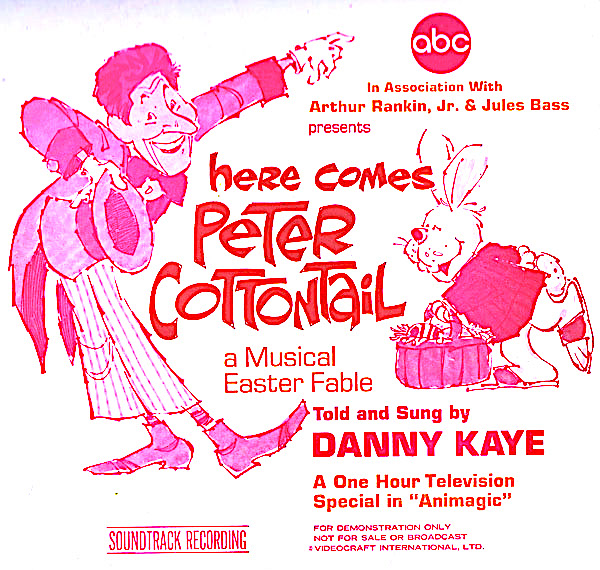
Fifty years ago, on the heels of one of their finest Christmas TV specials, an inimitable group of staff and freelance creative people who made up the Rankin/Bass animation (and occasional live-action) core team made lightning strike twice.
Here Comes Peter Cottontail, which premiered on the CBS network Sunday night, April 4, 1971, has proven to have as comparable a degree of evergreen appeal to new audiences and lasting attachment to its fans as Santa Claus is Comin’ to Town. That special, which we explored in a recent Animation Spin https://cartoonresearch.com/index.php/santas-been-comin-to-town-for-50-years-on-tv-and-records/, made its debut only three months earlier on ABC.
There can be little doubt that both projects overlapped, starting with the music. Composer/arranger Maury Laws and co-producer/director Jules Bass created a memorable original score for each, recorded partially in London with The Mike Sammes Singers (also heard throughout the fondly remembered Saturday morning series Tomfoolery, which was animated for Rankin/Bass by England’s Halas and Batchelor studio). Of Peter Cottontail, TV Guide said it had, “one of the best scores in children’s special history.”
 The 1971 special featuring nothing less than the best in every detail, visually presented in the crisp, iconic style of the great Paul Coker, Jr. Romeo Muller, this time unburdened by the need to craft a “legend” for the origin of the Easter Bunny, had a wonderful premise to build upon—the 1957 children’s book The Easter Bunny Who Overslept by Priscilla and Otto Fredrich.
The 1971 special featuring nothing less than the best in every detail, visually presented in the crisp, iconic style of the great Paul Coker, Jr. Romeo Muller, this time unburdened by the need to craft a “legend” for the origin of the Easter Bunny, had a wonderful premise to build upon—the 1957 children’s book The Easter Bunny Who Overslept by Priscilla and Otto Fredrich.
In the book, it is the Easter himself bunny (not Peter) who sleeps through Easter. and spends the rest of the year trying unsuccessfully to give away eggs on other holidays. At the North Pole, Santa Claus gives him a golden clock so he won’t oversleep again.
As Muller did for Rudolph—and deserved far more credit for doing so—the prolific writer added the concept of an Easter Bunny election and the time-traveling “Yestermorrowbile.” Just as he had created Hermie the elf, Yukon Cornelius and the Island of Misfit Toys for Rudolph, the Red-Nosed Reindeer, Muller this time gave the world whimsical characters such as the Willy Wonka-like Mister Sassafras (Danny Kaye); brave and loyal caterpillar Antoine (also Kaye); a hat with Mary Tyler Moore “Oh, Rob!” hysterics named Bonnie (Joan Gardner); and kooky “gal-next-door” Madame Esmeralda the witch (also Gardner). Also by Gardner is a small child voice reminiscent of her “Tiny Tim Mc Boing-Boing” in Mister Magoo’s Christmas Carol.
To accompany Gardner’s Esmeralda and the Halloween sequence, Maury Laws turned back to his score for the Mad Monster Party and wrote a new arrangement of his “Waltz for a Witch” from the earlier Rankin/Bass feature film.
Blissfully chewing the scenery and spewing it in all directions is Vincent Price, marking his first voice acting performance in an animated film. As January Q. Irontail, a hare so bitter and twisted he could be in the Marvel villain universe, Price’s Irontail revels in his evil cheating and can’t separate his hatred of others from himself. Unlike most Rankin/Bass villains, we never see Irontail have a change of heart (nor is he destroyed or diminished by the passage of time).
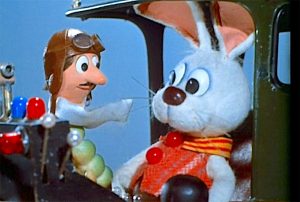 Instead, after the characters parade down for bunny trail finale, Irontail is seen “doing time” in community service by sweeping up the Animagic waste left behind. Of course, it’s all in fun. Moments later, we get a rare Rankin/Bass treat and see him with the whole cast, gathered for a curtain call at the end.
Instead, after the characters parade down for bunny trail finale, Irontail is seen “doing time” in community service by sweeping up the Animagic waste left behind. Of course, it’s all in fun. Moments later, we get a rare Rankin/Bass treat and see him with the whole cast, gathered for a curtain call at the end.
Danny Kaye was a great favorite of Arthur Rankin. The entertainer accompanied the producer to Japan, where he was able to see the progress of the animation and for the artists to study some of his movements as reference. (There is a section about Rankin and Kaye in the book, Nobody’s Fool written by Martin Gottfried.) Kaye also starred in another Rankin/Bass special, The Emperor’s New Clothes, which was actually a pilot for a series called The Enchanted World of Danny Kaye. Perhaps the network didn’t buy the series because it thought audiences would only want to see such things during the holidays.
 With a versatile vocalist like Danny Kaye in the cast, Paul Frees was not afforded the volume of voice roles he had in Santa Claus is Comin’ to Town, but his presence is always a plus. Casey Kasem was relatively new to animation at the time. Well-known to radio listeners in Southern California for years and an occasional guest actor on TV, he was becoming a familiar voice on Saturday mornings. Scooby-Doo, Where Are You? and Josie and the Pussycats were both hit CBS series when this special premiered. His American Top 40 radio show was only a year old, so his career was just ascending.
With a versatile vocalist like Danny Kaye in the cast, Paul Frees was not afforded the volume of voice roles he had in Santa Claus is Comin’ to Town, but his presence is always a plus. Casey Kasem was relatively new to animation at the time. Well-known to radio listeners in Southern California for years and an occasional guest actor on TV, he was becoming a familiar voice on Saturday mornings. Scooby-Doo, Where Are You? and Josie and the Pussycats were both hit CBS series when this special premiered. His American Top 40 radio show was only a year old, so his career was just ascending.
Sadly, to this day there is no officially licensed soundtrack album of Here Comes Peter Cottontail released for retail sales. The ABC promo album, a slightly edited “lift” of the soundtrack but still mixed and edited for vinyl, was never made available beyond business associates and potential sponsors and likely also to persuade record companies to convince them to release it commercially. One reason for their passing could have been that the Easter merchandise sales window is too short for such an album to sell enough copies to justify its costs.
It’s a shame that a legitimate LP or CD has yet to see the light of day. This is a great cast, a great score and it has all the holidays! There’s always hope. Miracles happen most every day.
“Be Mine Today” – Casey Kasem. Iris Rainer and The Mike Sammes Singers
Casey Kasem gives this fine song all the energy of a young Broadway romantic lead, with the verve of Robert Morse (who later did two Rankin/Bass specials). Musically, Iris Rainer was an ideal choice to complement Kasem’s vocal style. Later as author Iris Rainer Dart, her novel Beaches became a best-seller and a hit 1988 Bette Midler movie that launched the song “Wind Beneath My Wings.”
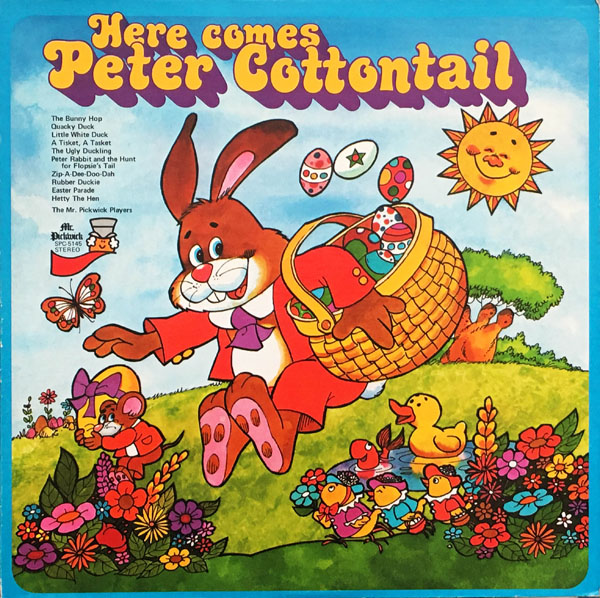
HERE COMES PETER COTTONTAIL
The Mr. Pickwick Players (Various Pickwick Artists)
Mr. Pickwick Records SPC-5145 (12” 33 rpm LP / Stereo & Mono)
Download available on iTunes and amazon [http://www.amazon.com/gp/product/B00481WIYS/ref=dm_ws_sp_ps_dp]
Released in 1975. Producer: “Bugs” Bower. Musical Direction: “Bugs” Bower, Maury Laws, Warren Vincent, Lew Raymond. Running Time: 35 minutes.
Performers Include: Ben Zeppa, Bill Marine, Betty Wells, Ron Marshall, Norman Rose, Dorothy Season, Jim Pollack, The Overtones, The Playmates, Berlin Symphony Orchestra.
Songs: “Here Comes Peter Cottontail” by Steve Nelson and Jack Rollins; “The Little White Duck”; “A Tisket, A Tasket” (Traditional); “The Bunny Hop” by Ray Anthony and Leonard Auletti; “Rubber Duckie” by Jeffrey Moss; “Zip-A-Dee-Doo-Dah” by Allie Wrubel and Ray Gilbert; “Easter Parade” by Irving Berlin; “Quacky Duck” (uncredited).
Stories: “Hetty the Hen” with Music by Warren Vincent, “Peter Rabbit and the Search for Flopsy’s Tale” with Music by Maury Laws, “The Ugly Duckling” with Excerpts from Tchaikovsky’s Swan Lake.
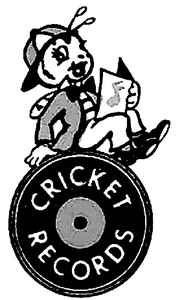 While the Steve Nelson/Jack Rollins song is actually called “Peter Cottontail,” one has to wonder whether Pickwick very wisely added the words “Here Comes” to the album’s title as a subtle tie-in, or at least a nod, to the Rankin/Bass special. We’ll never know, it’s difficult to recall any other records that also included “Here Comes” in the seventies when the special was still on CBS.
While the Steve Nelson/Jack Rollins song is actually called “Peter Cottontail,” one has to wonder whether Pickwick very wisely added the words “Here Comes” to the album’s title as a subtle tie-in, or at least a nod, to the Rankin/Bass special. We’ll never know, it’s difficult to recall any other records that also included “Here Comes” in the seventies when the special was still on CBS.
In his early days as a New York arranger/orchestrator/composer for hire, Maury Laws worked extensively with record companies that released hundreds of discs under numerous labels. Pickwick’s included Cricket, Happy Time and Mr. Pickwick; Peter Pan had Rocking Horse, Diplomat, Parade, Prom, Promenade, and more.
Another name associated with Laws’ work is Tom Pollack, who sang on Cricket Records and later became a partner in the music production firm Forrell, Thomas and Pollack, whose projects include the excellent Firestone Christmas albums. Arthur Rankin and Jules Bass worked in advertising before their partnership, so they were probably familiar with FTP as a music resource for commercials and industrial projects.
When he started Videocraft International, Rankin hired Forrell, Thomas and Pollack to work on The New Adventures of Pinocchio and an album for that TV series was released on their “FTP label (see this Spin). Rankin and Bass also turned to FTP when General Electric sponsored their first Rankin/Bass TV special, Return to Oz, Maury Laws did the orchestration, as he did for FTP’s Firestone Christmas albums.
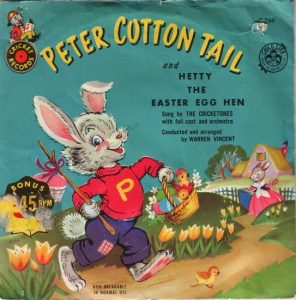 The album itself, like a lot of the “Mr. Pickwick” records of the ‘70s, is a compilation of previously released single records from the Cricket library. The earliest recording is “The Ugly Duckling” from 1953 and the most recent is “Rubber Duckie,” in true stereo, from 1970. Several of these records have been made available for download.
The album itself, like a lot of the “Mr. Pickwick” records of the ‘70s, is a compilation of previously released single records from the Cricket library. The earliest recording is “The Ugly Duckling” from 1953 and the most recent is “Rubber Duckie,” in true stereo, from 1970. Several of these records have been made available for download.
“Hetty the Hen” is notable as one of the early examples of children’s records with social messages. It was an original Cricket musical story released in 1955 as the “B” side to “Peter Cottontail.” In this short fable, Hetty lives happily on a farm until the day she, for no apparent reason, begins laying eggs of different colors than usual. The other animals shun Hetty. Her fellow hens stop laying eggs until she is taken away, saying, “We don’t want a ‘something like that’ living near.” Suddenly “everyone wanted to be Hetty’s friend.” As if to address their superficial acceptance of her and her eggs, Hetty delivers a heartfelt speech about being accepting differences. Pickwick Records kept “Hetty the Hen” in circulation on Happy Time label in the sixties and on numerous LP compilations in the seventies.
The most recent recording on the album is 1970’s “Rubber Duckie” sung by Ron Marshall, another Rankin/Bass alumnus from The Year Without a Santa Claus and The Easter Bunny is Comin’ to Town. The earliest track comes from 1953: “The Ugly Duckling” narrated by master voice artist Norman Rose, who among many things, was a house announcer for NBC in the sixties.
“Peter Rabbit and the Search for Flopsy’s Tail”
Even though Maury Laws’ orchestra is small in this cutesy musical story, you can hear the trademark accents and flourishes that would later distinguish his work for Rankin/Bass. It’s a fascinating glimpse into the process of a great musician setting the groundwork for what would become his signature style. For those seeking further Laws work on Pickwick and Peter Pan labels, listen for the distinctive voices of Betty Wells and Bill Marine as heard on this track, as he often worked with them.
This article is an extensively revised version of an earlier post.


 GREG EHRBAR is a freelance writer/producer for television, advertising, books, theme parks and stage. Greg has worked on content for such studios as Disney, Warner and Universal, with some of Hollywood’s biggest stars. His numerous books include Mouse Tracks: The Story of Walt Disney Records (with Tim Hollis). Visit
GREG EHRBAR is a freelance writer/producer for television, advertising, books, theme parks and stage. Greg has worked on content for such studios as Disney, Warner and Universal, with some of Hollywood’s biggest stars. His numerous books include Mouse Tracks: The Story of Walt Disney Records (with Tim Hollis). Visit 





















































Fascinating connections between the Pickwick album and Rankin/Bass productions! The story given here of “Peter Rabbit” is certainly loaded with decent production values and quality voice work.
One thing to note about the Rankin/Bass Easter specials is that every one of them contains elements of Christmas. Perhaps this is not too surprising, considering that by the early 70’s Rankin/Bass had nearly cornered the market on animated Christmas specials. There seems to be less secular folklore attached to Easter than there is for Christmas, so perhaps R/B were feeling their way. By including scenes of Christmas, Hallowe’en, St. Valentine’s Day, St. Patrick’s Day and so forth, doubtless there was less pressure to make it a “pure” Easter story. Similarly, the hand-drawn special “The First Easter Rabbit” begins at Christmas and prominently features the character of Santa Claus. The special that focuses most strongly on Easter itself, “The Easter Bunny is Comin’ to Town” (by this time R/B seem to be more comfortable with concentrating on the one holiday instead of tying it in with others) still is derivative of the previous “Santa Claus is Comin’ to Town” in not only its title but in the re-appearance of S.D. Kluger voiced by Fred Astaire, who serves as narrator once again. And it makes use of the “origins” template that was employed to such good effect in the “Santa Claus” special. Just as the Easter Bunny is considered somewhat derivative of Santa Claus, so the R/B Easter specials make the connection with Christmas. Of course, in a spiritual, liturgical, and theological sense, Christmas and Easter are directly linked, but that is a discussion for another time and place.
This is in no way intended as criticism of the Rankin/Bass take on Easter. In a sense, Easter is a much more sensitive holiday, and a little less secularized, than Christmas, and as a subject for family entertainment it requires a delicate approach. And Rankin/Bass in their unique style managed to dish up their usual concoction of delights to charm young and old alike.
I was fascinated by your mention of the Firestone Christmas albums. I’m trying to find out more information about them, because arguably they are among the very finest Christmas albums ever produced. If there are any good sources that provide details of the production of these albums, I would be interested.
I’m not familiar with the Firestone Christmas albums, but Firestone was a major sponsor of classical music programming on radio and television for many years. The Firestone Hour (later the Voice of Firestone) was broadcast on NBC radio from 1928 to 1957, hosted for much of that time by the popular tenor Richard Crooks. It had a great impact on American cultural life and launched some distinguished musical careers. For example, Crooks promoted and toured with the Scottish viola virtuoso William Primrose, who became one of the first violists to perform and record primarily as a solo artist rather than as an orchestral player.
On television, the Voice of Firestone aired on NBC from 1943 to 1954 and then on ABC until its cancellation in 1959 (with a brief revival in the 1962-63 season). It was the first American TV program focused on music, and one of the first not devoted to news or sports. Firestone had its own orchestra (conducted by Howard Barlow, formerly music director of the Baltimore Symphony Orchestra) and its own chorus, along with a regular roster of vocal and instrumental soloists. I’m only guessing, but it seems probable that the Firestone Christmas albums were recordings of music that had been featured on the show at Christmastime. Firestone donated all documents and recordings related to their radio and TV shows to the New England Conservatory in Boston, so the information you’re looking for is probably in the archives there.
Thanks for the information. It is fascinating to me that a tire company would associate itself so strongly with classical music.
What I do know about the Christmas albums is that they were produced in the mid to late 60’s. I appreciate your suggestion that they may have been culled from earlier archived tracks, but the few sources I have found indicate that this was not the case. These were studio recordings, not compilations of earlier material. The usual format was to feature classical artists and/or pop singers, and each album was arranged in the style of a concert. Volumes One and Two featured Rise Stevens and Brian Sullivan, Volume Three featured Gordon MacRae, Martha Wright, Franco Corelli and Roberta Peters. Volume Four had Julie Andrews, Vic Damone, Dorothy Kirsten, and James McCracken, while Volume Five featured Julie Andrews as the sole vocalist backed up by Andre Previn and the Firestone Orchestra. Six had Jack Jones, Roberta Peters, and the Vienna Choirboys, and Seven featured Leontyne Price, Vikki Carr, John Gary, Nicolai Gedda, and the Vienna Choirboys. The recordings used on the Julie Andrews Christmas Album appear to have originated on Firestone Volume Five.
If you are already a fan of Firestone’s other productions, you will definitely appreciate the richness of these recordings.
What I’m really wondering about is the creative decision to record fresh material for these albums rather than simply repackaging existing tracks as was done with the Montgomery Ward albums and other similar promotional Christmas albums released by other companies. Firestone went to a lot of time and expense to produce these and as I mentioned they are a cut above your average Christmas recordings.
Rise Stevens, Brian Sullivan and Roberta Peters were regulars on the Voice of Firestone. Some of the other singers you mentioned may have appeared on the show as well, as it often featured Broadway stars. As for why Firestone would associate itself with classical music, (1) Mrs. Harvey Firestone was a music lover, arts benefactress and a composer herself; and (2) it’s just good for business, like Texaco sponsoring the radio broadcasts of the Metropolitan Opera when I was growing up.
“Here Comes Peter Cottontail” has a delightful little in-joke for us Edgar Allan Poe fans. Irontail’s bat is named Montresor, who was the narrator in Poe’s short story “The Cask of Amontillado”. In the adaptation of the story in Roger Corman’s 1962 anthology film “Tales of Terror”, Peter Lorre played Montresor to Vincent Price’s Fortunato.
And on a related topic, in the same year that “Here Comes Peter Cottontail” premiered, Casey Kasem appeared in the American International horror film “The Incredible Two-Headed Transplant” with Bruce Dern and Marilyn Munster — that is, Pat Priest. Evidently his “ascending career” had the odd bump in it.
Danny Kaye’s trip to Japan with Jules Bass was not his first. He had toured that country with a vaudeville troupe in the thirties, where, not knowing the language, he honed his skills as a physical comedian. Later the troupe continued on to China, where Danny developed his love of Chinese cooking. The Chinese banquets at his home were renowned in Hollywood, not only for the excellence of the cuisine but for their eclectic guest lists: Humphrey Bogart and Ava Gardner might share the table with Danny’s mechanic and the teller at his bank. He kept a database of index cards to make sure that no guest ever had the same dish twice.
Danny Kaye was greatly beloved by orchestral musicians of my teachers’ generation as a skillful and sensitive orchestra conductor. One of my teachers had a framed, autographed photo of him on the wall alongside Toscanini, Reiner, Mitropoulos, and others; and when I asked him about it, he said Danny was as good a conductor as any of them and better than most. He conducted hundreds of concerts with symphony orchestras all over the world, never accepting a cent in payment, but raising millions of dollars for musicians’ pension funds. This was only part of his charitable work, notably as an ambassador for UNICEF. The warmth and kindness of this fantastically talented entertainer always shone through in his performances, not least in “Here Comes Peter Cottontail”.
Mr. Ehrbar:
I was hoping you’d have a revised version of your PETER COTTONTAIL post for us in time for Easter this year, and you did not disappoint. A fine look back at a great many yestermorrows!
You’re in for more treats because our colleague Michael Lyons wrote even more about the special on Jerry other website, Animation Scoop:
http://www.animationscoop.com/24-carrot-gold-the-50th-anniversary-of-rankin-bass-here-comes-peter-cottontail/
“Here Comes Peter Cottontail” and “Santa Claus is Comin’ To Town” are my all-time favorite Rankin/Bass specials. I’ve loved both specials since I was little. In both shows, everything works: the story, the characters, the cast, the music, the songs, the animation and Paul Coker Jr.’s designs. The songs in “Peter Cottontail” are awesome and so is Maury Laws’ score. His overture at the beginning of “Peter Cottontail” is my favorite of all the overtures he wrote for the Rankin/Bass specials. “Here Comes Peter Cottontail” is definitely the best of Rankin/Bass’ three Easter specials. I too hope someday there will be an official CD soundtrack of the special.
I absolutely love that overture and listen to it over and over again.
I’m old and grumpy enough now that I think that black and green Easter eggs and chocolate spiders and octopuses would be kind of cool.
I also dig that flying time machine for being Steampunk before there was Steampunk.
Although the time travel didn’t make sense even by time travel standards. Wouldn’t they want to do a short skip backwards instead of going through the whole year forwards?
Well, that’s a thing my siblings and I call “Giligan’s Law.” The book also sends the Easter Bunny forward through the holidays rather than backward.
Time travel is a very difficult plot device. There is a moment in which Irontail’s spider rewires the Yestermorrowbile and the “skip Easter” implying that they did indeed try to go back. The special would be odd if they presented the holidays in reverse order, especially for young kids.
So, Gilligan’s Law triumphs again. One of its tenets is that it can cause headaches if thought about for too long. (Why didn’t they build a second raft, or swim home like some of the guest stars? Ouch!)
You know why kids are so mean and unhappy today? Because nobody’s making holiday specials for them. We children of the ’60s and ’70s and kind of the ’80s truly lucked out in that regard. The shows, with their elaborate storylines, were goofy (which we knew and loved them for it) and haven’t aged well, but they were wonderful in their unique way. Poor herky-jerky “Animagic” must look lame to a generation brought up on CGI (in “Real 3D”); but at least it had charm, which is more than you can say for today’s animated offerings. The kids can stream vintage Rankin/Bass, of course, but it won’t mean the same to them. You had to be there–back when TV was a weekday evening and Saturday morning escape from the real-world routine. Now the screen is the kids’ routine because they haven’t got much else. Their fantasy comes in three flavors: sinister, smart-ass, and smarmy.
I am a regular Scrooge who hates holidays but must admit that the Rankin-Bass specials have made them easier for me to stomach them. This one has always been my personal favorite. Then again, nobody milked that other annual pagan ritual better than the original RUDOLPH and THE YEAR WITHOUT A SANTA CLAUS. There are many interesting similarities between this one and the later RUDOLPH’S SHINY NEW YEAR, which has its own time-travel situation but involving past “island years” instead of holidays.
“If I Could Only Get Back to Yesterday” was way too sophisticated of a song for many young tykes, but it emphasizes just how sophisticated this TV special really was. https://www.youtube.com/watch?v=ftYEanbt5yU
You hit upon a highly significant reason why the work of Rankin/Bass continues to endure for generations. All of these people knew how to entertain a large audience well, and to keep them compelled by what they saw and heard.
“If I Could Only Get Back to Yesterday” is a very yearning song performed with a blend of regret and a knowing grin of mature realization that one really cannot go back. The arrangement propels the scene (and the Yestermorrowbile) with a country beat and it seems bright, yet there are the Mike Sammes Singers adding a touch of empathy.
There’s a lot going on there, yet it goes by so fast. It’s not all supposed to consciously register. Obviously it does get through, though, because this is still a CURRENT, therefore “relevant,” title.
Robie Lester’s “My World’s is Beginning Today” and Red Skelton’s “The Moving Finger Writes” are also in this category. Some kids might be tuning out the “boring slow songs” like this, but not sharper kids like us and not the adults.
… and, looking back, the Japanese-U.S. Rankin-Bass productions that started in the sixties and really hit their stride during the seventies did represent a golden age for animation that tends to be overlooked in print. They were always special events getting plenty of promotion and rebroadcast by popular demand; obviously superior to what we normally saw on Saturday morning (including other efforts sporting the Rankin-Bass umbrella a.k.a. THUNDERCATS). Sometimes they even surpassed anything Disney put out (not that there was much competition there apart from, maybe, THE RESCUERS).
Even though I had outgrown them by the end of the decade and into the 1980s, the later efforts like JACK FROST and THE LIFE AND TIMES OF SANTA CLAUS are not bad at all. I do recall that the latter production got plenty of media attention in 1985. While hardly a masterpiece in the same sense as HERE COMES PETER COTTONTAIL, it at least brought a two decade run of these stop-motion spectaculars to a satisfying finish.